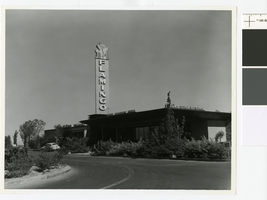Search the Special Collections and Archives Portal
Search Results

Photograph of the Flamingo Hotel courtyard and swimming pool area (Las Vegas), late 1960s
Date
Archival Collection
Description
View of the courtyard and swimming pool at the Flamingo Hotel.
Site Name: Flamingo Hotel and Casino
Address: 3555 Las Vegas Boulevard South
Image

Photograph of opening day at the Riviera's Starlight Lounge (Las Vegas), April 21, 1955
Date
Archival Collection
Description
The Starlight Lounge at the Riviera on its opening day, April 21, 1955. The grand opening of the Riviera was one day earlier.
Site Name: Riviera Hotel and Casino
Address: 2901 Las Vegas Boulevard South
Image

Photograph of the Las Vegas Strip, circa 1969
Date
Archival Collection
Description
Las Vegas Strip looking south showing the Riviera, the Stardust, and the Frontier Hotel. Per patron comment, the photo may have been taking around 1969.
Site Name: Las Vegas Strip
Address: Las Vegas Boulevard, Las Vegas, NV
Image

Photograph of the El Cortez Hotel (Las Vegas), circa 1950s
Date
Archival Collection
Description
El Cortez Hotel in the 1950's. Stamp on back of photo: "Las Vegas News Bureau, Convention Center, Las Vegas, NV, 89019, 5797."
Site Name: El Cortez
Address: 600 East Fremont Street, Las Vegas, NV
Image

Photograph of the Las Vegas International under construction (Las Vegas), January 6, 1969
Date
Archival Collection
Description
International Hotel, now the Las Vegas Hilton, while it was under construction. Sticker on back of photo: "LV Hilton (International) with convention center, 1/6/69, Donn Knepp/Las Vegas News Bureau."
Site Name: International Hotel
Address: 3000 Paradise Road
Image

Photograph of the original Googie style Flamingo front entrance (Las Vegas), late 1940s
Date
Archival Collection
Description
View of the original front of the Flamingo Hotel and Casino.
Site Name: Flamingo Hotel and Casino
Address: 3555 Las Vegas Boulevard South
Image

Photograph of the Flamingo sign (Las Vegas), late 1940s
Date
Archival Collection
Description
The original sign at the Flamingo Hotel and Casino. Sticker on back of photo: "Please Credit Las Vegas News Bureau, 0771, Photographers Jerry Abbot, John Litty, Don English, Tony King, Milt Palmer, Wolf Wergin, John Gurzinski, Convention Ctr. Las Vegas, NV 89019, (702)735-3611, Bureau MGR. Don Payne."
Site Name: Flamingo Hotel and Casino
Address: 3555 Las Vegas Boulevard South
Image

Photograph of the MGM Grand Hotel Fire (Las Vegas), November 21, 1980
Date
Archival Collection
Description
Smoke pouring out of the MGM Grand, now Ballys, on November 21, 1980. Stamp on back of photo: "R-J Photo by Scott Henry." The MGM Grand Hotel was rebuilt in 1981 and sold to Bally's Corporation to become Bally's Las Vegas in 1985.
Site Name: MGM Grand Hotel
Address: 3645 Las Vegas Boulevard South, Las Vegas, NV
Image

Photograph of the Sands Hotel front entrance (Las Vegas), circa 1980
Date
Archival Collection
Description
The front entrance and porte-cochère at the Sands Hotel, Las Vegas, circa 1980. Note: Per patron comment, this photograph may be from 1982.
Site Name: Sands Hotel
Address: 3355 Las Vegas Boulevard South
Image

Aerial photograph of the Las Vegas Strip, early 1980s
Date
Archival Collection
Description
Aerial view of the Las Vegas Strip, looking north over the Stardust, Circus Circus, and the Riviera. Stamp on back of photo: "Photos by Ken Jones, Nov 1, 1981."
Site Name: Las Vegas Strip
Address: Las Vegas Boulevard, Las Vegas, NV
Image
